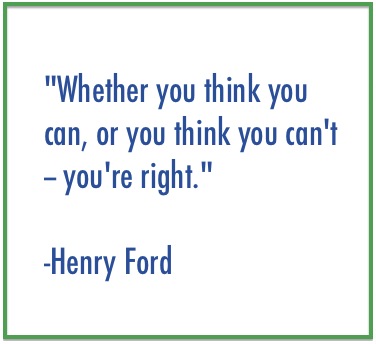 Meme Credit: HealthyPsych.com
Meme Credit: HealthyPsych.com As referenced in other material on healthypsych, “cognitive distortions” refer to biased ways we humans think about ourselves and others. The term has its origins in cognitive-behavioral therapy theory and practice.
While these automatic thought patterns can lead to negative emotional states and behaviors, they can also be mitigated through various means. This post outlines a systematic way to challenge the validity of these distortions, by replacing them with more rational, realistic and broad-minded thoughts (i.e., self-talk).
Cognitive distortions are ingrained and reflexive thoughts that have their roots in some conditioning (i.e., learning) from the past. They tend to be judgmental, unreasonable and oftentimes extreme. Because they are so automatic, we often aren’t aware of them and consequently, don’t question their validity.
Some examples of common cognitive distortions are:
1.) All-or-nothing thinking: seeing things in black or white terms, rather than noticing the gray areas. Perfectionism is often an indicator that this distortion is at play.
2.) “Should” statements: thoughts that are imbued with expectation, judgment, and pressure, like “I should be better” (rather than “I’d like to be better”).
3.) Predicting the future: making assumptions about what is going to happen, often with a negative bias, instead of recognizing the inherent uncertainty in any situation.
4.) Mind reading: assuming you know what other people are thinking, rather than relying on explicit communication.
A comprehensive list of cognitive distortions is available here.
In addition to learning about these common thought patterns and how they impact your life, the “Challenging Cognitive Distortions” exercise can help you chip away at the ill effects that distorted thinking causes. In turn, this process is designed to “strengthen your muscle” of rational, broad-based, and self-supportive thinking.
It’s important to note that rational or realistic thinking may still lead to uncomfortable emotions, like sadness or fear. Feeling a variety of emotions is not only human, but is also an integral part of healthy psychological functioning. For example, it’s a normal (and necessary) to feel emotions like sadness or anger when you think about somebody dying or leaving. And, it’s important to feel fear under truly scary circumstances, like if your house was on fire. The thought “my house is on fire, I better get out of here,” that is followed by fear, is an example of a rational thought and feeling sequence. Alternatively, the thought “the world is going to end if I fail that exam” (that leads to fear) is not a rational thought-feeling sequence. The latter is an example of catastrophic thinking – another classic cognitive distortion. A more rational perspective would be something like “if I fail that exam, I will probably feel pretty disappointed and likely experience negative consequences, like having to spend even more time studying to retake it.”
So, while automatic thoughts will arise (researchers estimate that the human mind produces somewhere between 12,000 and 60,000 thoughts per day), you can put yourself in the best position to achieve psychological wellbeing, by noticing and working with the cognitive distortions in there. The goal isn’t to eradicate uncomfortable emotions (this is impossible), but rather to do your best thinking about yourself and others…and when that’s done, people tend to not experience the excess suffering that distorted thinking can produce.
Instructions for Challenging Cognitive Distortions
1.) Download the “Challenging Cognitive Distortions” worksheet. As you can see, there are 4 columns to fill-out: Thoughts, Feelings, Cognitive Distortions, and Challenges.
2.) The relationship between thoughts and feelings: The first two columns are to track how thoughts contribute to feeling states. Identify a repetitive thought that you have and write that in the first column. Next, identify any emotions or physical sensations (e.g., back tension) that you experience when you hold that thought, and write those down in the second column.
3.) Identify the Cognitive Distortion: look at the list of cognitive distortions and evaluate your thought for any. If you find that there is a cognitive distortion in your thought, write it down in that column. If there isn’t a cognitive distortion, then great; just move on to another example. Sometimes a thought may have more than one cognitive distortion in it.
4.) Challenging the Cognitive Distortion: If you do identify a cognitive distortion – and with repetitive, obsessive thoughts there usually is one – then in the last column, think of an alternative, rational thought to say to yourself instead. Write that down. Remember that rational perspectives are typically broader, vs. black-and-white or overly negative viewpoints. They also tend to be more realistic and compassionate.
If you’re having a hard time coming up with a challenge to your cognitive distortion, imagine what you’d say to a good friend in the same position.
You can also ask yourself what the likelihood is that a particular thought is true. Imagine you’re a scientist who is objective, looking at the facts, not the speculation, you know to be true about yourself and others. With a cognitive distortion, you’ll often find that there’s a pretty low chance that the thought is true; whereas with a rational thought, the percentage is usually much higher.
NOTE: as with many cognitive-behavioral therapy exercises, it’s important that you actually write down the information that you’re analyzing. It’s much harder to get good perspective by just keeping it all in one’s mind. Writing it down helps bring more clarity and facilitates a more rational process.
Source: Burns, David D., MD. 1989. The Feeling Good Handbook. New York: William Morrow and Company

Leave a reply
You must be logged in to post a comment.